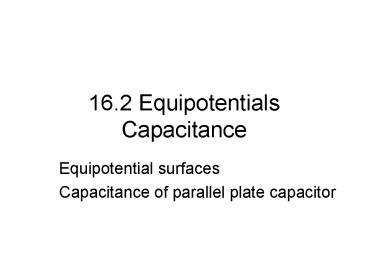16'2 Equipotentials Capacitance - PowerPoint PPT Presentation
1 / 16
Title:
16'2 Equipotentials Capacitance
Description:
... of the equipotential surfaces for a electric dipole q q. q -q. V ... Camera flash, capacitor in automobile starting system, capacitors in electronic devices ... – PowerPoint PPT presentation
Number of Views:39
Avg rating:3.0/5.0
Title: 16'2 Equipotentials Capacitance
1
16.2 EquipotentialsCapacitance
- Equipotential surfaces
- Capacitance of parallel plate capacitor
2
Electron volt- unit of energy
?PE q?V Where qe 1.6x10-19C 1eV
1.6x10-19 J Useful for atomic properties.
The potential at Na due to Cl- was -6.0V. Energy
of Na ion at this position is PEeV-6.0
eV PE-6x1.6x10-19 9.6x10-19J
3
Equipotential Surface - positions in space at
which the electrical potentials are equal
Example 1- A sphere centered around a point charge
Every point on the surface of the sphere of
radius r has the same potential
Vkeq/r
r
q
4
Equipotential surface-
Example 2 a charged conductor
The surface of a conductor is an equipotential
surface.
E
E field is perpendicular to the surface.
- Component of E 0 parallel to the surface
- ?VEd0
- No change in potential along the surface
equipotential
5
The interior of the conductor is an equipotential
and at the same potential as the surface.
E0 in the conductor Thus, the potential doesnt
change from the surface potential
V
V
6
The equipotential surfaces are perpendicular to E
field lines.
Equipotential
7
Draw a sketch of the equipotential surfaces for a
electric dipole q q.
V0
Vgt0
Vlt0
-q
q
8
Capacitance
Capacitor- a device for storing charge (energy) -
can be discharged rapidly to release
energy Examples. Camera flash, capacitor in
automobile starting system, capacitors in
electronic devices
9
Parallel Plate Capacitor Metal plates separated
by an air gap
q
A
?V
d
-q
Capacitance
Units C/V farad (F)
10
A 100 microfarad capacitor is charged to 100 V.
How much charge does it store?
11
What is the capacitance of a parallel plate
capacitor with plates of area A separated by
distance d?
q
A
?V
d
-q
Recall
rearrange
thus
12
- A parallel plate capacitor with 2 plates each
with area 1.0 m2 separated by a distance of 1.0
mm. - Find the capacitance.
- Find the E field if the plates hold q,-q,
q10-6C - Find ?V across the plates
(a)
13
- A parallel plate capacitor with 2 plates each
with area 1.0 m2 separated by a distance of 1.0
mm. - Find the capacitance.
- Find the E field if the plates hold q,-q,
q10-6C - Find ?V across the plates
(b)
14
- A parallel plate capacitor with 2 plates each
with area 1.0 m2 separated by a distance of 1.0
mm. - Find the capacitance.
- Find the E field if the plates hold q,-q,
q10-6C - Find ?V across the plates
(c)
15
A parallel plate capacitor with 2 plates each
with area 1.0 m2 separated by a distance of 1.0
mm, and charge q.
- If the distance between the plates was increased
by a factor of 2 how does E change? - How does ?V change?
These are all constant. Thus, E is unchanged
(a)
16
A parallel plate capacitor with 2 plates each
with area 1.0 m2 separated by a distance of 1.0
mm, and charge q.
- If the distance between the plates was increased
by a factor of 2 how does E change? - How does ?V change?
E is constant d increases by 2-fold thus ?V
increases by 2-fold
(b)































